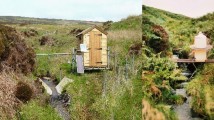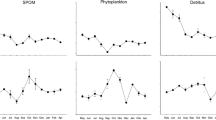Abstract
Inverse methods were used with measurements of sediment (POC) fluxes and total benthic metabolism to infer the roles of the different food-web components in the benthos of the sub-oxic Santa Monica basin off Southern California. High nitrate and sulfate fluxes into the sediments observed there guaranteed that anaerobic bacteria would have important roles. We were able to estimate the relative roles of the bacteria and the grazers that prey on the bacteria for several alternative food-web flow structures.
Our analysis showed high carbon consumption by anaerobic bacteria; an inverse relationship between grazer size and consumption rate; and more consumption of carbon by anaerobic than by aerobic grazers. Low production efficiency of anaerobic metabolism caused much of the carbon entering the benthos to be respired by the bacteria, rather than being used in bacterial growth. Bacteria consumed material poor in nitrogen while the grazers consumed material rich in nitrogen. Although bacteria consumed more carbon than did the grazers, the bacteria released equal amount of ammonia. Small protozoan microfauna consumed and mineralized most of the material available to the grazer populations.
The assumed mode of grazer feeding affected not only their bacterial consumption but also bacteria production. When bacteria were the only food for the grazers, the increased bacterial consumption was accompanied by an increase in bacterial production efficiency such that highly grazed anaerobic bacteria rivaled the efficiencies found in moderately grazed aerobic bacteria. Because of high bacterial production efficiencies, the additional link in the food-web when bacteria were the only grazer food source caused only a small absolute difference in the transfer efficiency (4% when detrital feeding was allowed and 2% when it was not).
Access this chapter
Tax calculation will be finalised at checkout
Purchases are for personal use only
Preview
Unable to display preview. Download preview PDF.
Similar content being viewed by others
References
Azam, F., T. Fenchel, J.G. Field, J.S. Gray, L.A. Meyer-Reil and F. Thingstad. 1983. The ecological role of water-column microbes in the sea. Mar. Ecol. Prog. Ser. 10: 257–363.
Brittain, A.M. and D.M. Karl. 1990. Catabolism of tritiated thymidine by aquatic microbial communities and incorporation of tritium into RNA and protein. Appl. Environ. Microbiol., 56: 1245–1254.
Cammen, L.M. 1980. Ingestion rate: an empirical model for aquatic deposit feeders and detritivores. Oecologia, 44: 303–310.
Cammen, L.M. 1989. The relationship between ingestion rate of deposit feeders and sediment nutrient value. In: Coastal and estuarine studies. Eds.: G. Lopez, G. Taghon, and J. Levinton. Springer-Verlag. pp. 201-222.
Carman, K. R., F.C. Dobbs, and J.B. Guskert 1988. Consequences of thymidine catabolism for estimates of bacterial production: An example from a coastal marine sediment. Limnol. Oceanogr. 33: 1595–1606.
Carey, D.A. and L.M. Mayer. 1990. Nutrient uptake by a deposit-feeding enteropneust: nitrogenous sources. Mar. Ecol. Prog. Ser., 62: 79–84.
Caron, D.A., J.C. Goldman, O.K. Andersen and M.R. Dennett. 1985. Nutrient cycling in a microflagellate food chain: II. Population dynamics and carbon cycling. Mar. Ecol. Prog. Ser. 25: 23–30
Chanton, J.P. and C.S. Martens. 1987. Biogeochemical cycling in an organic-rich coastal marine basin. A sulfur isotopic budget balanced by differential diffusion across the sediment-water interface. Geochim. Cosmochim. Acta. 51: 1201–1208.
Coale, K.H. 1990. Labyrinth of doom: A device to minimize the “swimmer” component in sediment trap collections. Limnol. Oceanogr. 35: 1376–1380.
Eldridge, P.M. and G.A. Jackson. 1991. An inverse analysis of benthic food webs. In preparation.
Fenchel, T. 1982. Ecology of heterotrophic microflagellates. II. Bioenergetics and growth. Mar. Ecol. Prog. Ser. 8: 225–231.
Fenchel, T. 1987. Ecology of protozoa. The biology of free-living phagotrophic protists. Science Tech Publishers, Madison, Wisconsin. p 197.
Fenchel, T. and T.H. Blackburn. 1979. Bacteria and mineral cycling. Academic Press, London.
Hemmingsen, A.M. 1960. Energy metabolism as related to body size and respiration surfaces, and its evolution. Reports of the Steno Memorial hospital and Nordinsk Insulin Laboratorium 9: 6–100
Hargrave, B.T. 1970. The effect of a deposit-feeding amphipod on the metabolism of benthic microflora. Limnol. Oceanogr. 15: 21–30.
Hooper, A.B. 1989. Biochemistry of the nitrifying lithoautotrophic bacteria. In:. Autotrophic bacteria. Eds.: uH.G. Schlegel and B. Bowien. Springer-Verlag, Berlin. pp. 239–266.
Jackson, G.A., F. Azam, A.F. Carlucci, R.W. Eppley, P. Williams, B. Finney, C. Huh, L.F. Small, D.S. Gorsline, B. Hickey, R A. Jahnke, I.R Kaplan, M.I. Venkatesan, M.R. Landry, K.M. Wong. 1989. Elemental cycling and fluxes off southern California. Eos 70: 146–149, 154 155.
Jackson, G.A. and P.M. Eldridge. 1991. Food web analysis of a planktonic system off southern California. Submitted to Prog. in Oceanogr.
Jahnke, R,A. 1990. Early diagenesis and recycling of biogenic debris at the seafloor, Santa Monica Basin, California. J. Mar. Res. 48: 413–436.
Jahnke, R.A., C.E. Reimer and D.B. Craven 1990. Intensification of recycling of organic matter at the seafloor near ocean margins. Nature. 348: 50–54.
Jorgensen, B.B. 1977. Bacterial sulfate reduction within reduced microniches of oxidized marine sediments. Mar. Biol. 41: 7–17.
Lochte, K. and C.M. Turley. 1988. Bacterial and cyanobacteria associated with phytodetritus in the deep sea. Nature 333: 67–69.
Lovley, D.R and E.J.P. Phillips. 1989. Requirement for a microbial consortium to completely oxidize glucose in Fe(III)-reducing sediments. Appl. Environ. Microbiol. 55: 3234–3236.
Rice, D.L. and D.C. Rhoads 1989. Early diagenesis of organic matter and the nutritional value of sediments. In:. Coastal and estuarine studies. Eds.: G. Lopez and G. Taghon. Springer-Verlag, New York. pp 59–97.
Sorensen, J. 1982. Reduction of ferric iron in anaerobic, marine sediment and interaction with reduction of nitrate and sulfate. Appl. Environ. Microbiol. 43: 319–324.
Steele, J.H. 1974. The structure of marine ecosystems. Cambridge, Mass., Harvard University Press. pp 128.
Stouthamer, A.H. 1988. Dissimilatory reduction of oxidized nitrogen compounds. In: Biology of anaerobic microorganisms. Ed.: A.J.B. Zehnder, John Wiley & Sons, New York, pp. 245–304.
Stumm, W. and J.J. Morgan 1981. Aquatic chemistry: an introduction emphasizing chemical equilibria in natural waters. 2nd ed. John-Wiley & Sons New York. pp. 780.
Tenore, K.R. and D.L. Rice. 1980. A review of trophic factors affecting secondary production of deposit-feeders. In: Marine benthic dynamics. Eds.: K.R. Tenore and B.C. Coull. University of S. Carolina Press. Columbia. pp. 325–340.
Thompson, B., J. Dixon, S. Schroeter, D.J. Reish. 1990. Ecology of the southern California bight. A synthesis and interpretation. Vol. 2. U. S. Department of the Interior, Minerals Management Service, Pacific OCS Region, Los Angeles, California. Ocean Studies Institute, California State University, Long Beach, California. pp 86.
U.S. GOFS 1988. Sediment Trap technology and sampling. Eds.: O. Knauer and V. Asper. U.S. GOFS Planning Report Number 10 August 1989. pp. 94.
Vezina, A.F., and T. Platt. 1988. Food web dynamics in the ocean. I. Best-estimates of flow networks using inverse methods. Mar. Ecol. Prog. Ser., 42: 269–287.
Walsh, I., K. Fischer, D. Murray, and J. Dymond. 1988. Evidence for resuspension of rebound particles from near-bottom sediment traps. Deep-Sea Res. 35: 59–70.
Ward, B.B., H.E. Glover, and F. Lipschultz. 1989. Chemoautotrophic activity and nitrification in the oxygen minimum zone off Peru. Deep-Sea Res. 36: 1031–1051.
Author information
Authors and Affiliations
Editor information
Editors and Affiliations
Rights and permissions
Copyright information
© 1992 Springer Science+Business Media Dordrecht
About this chapter
Cite this chapter
Eldridge, P.M., Jackson, G.A. (1992). Benthic Food Web Flows in the Santa Monica Basin Estimated Using Inverse Methodology. In: Rowe, G.T., Pariente, V. (eds) Deep-Sea Food Chains and the Global Carbon Cycle. NATO ASI Series, vol 360. Springer, Dordrecht. https://doi.org/10.1007/978-94-011-2452-2_16
Download citation
DOI: https://doi.org/10.1007/978-94-011-2452-2_16
Publisher Name: Springer, Dordrecht
Print ISBN: 978-94-010-5082-1
Online ISBN: 978-94-011-2452-2
eBook Packages: Springer Book Archive




